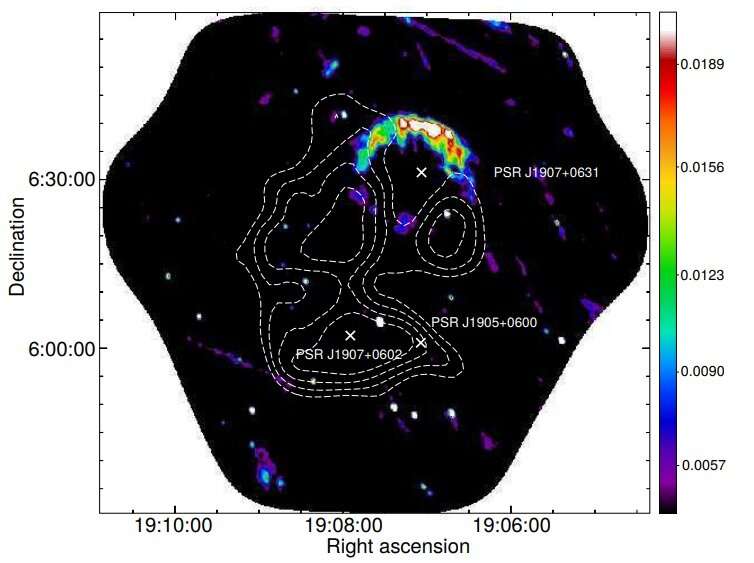January 10, 2020 report
Study probes the origin of the very high energy gamma-ray source VER J1907+062

A new study based on high-quality radio observations with the Karl G. Jansky Very Large Array (VLA) has investigated the origin of a very high-energy gamma-ray source known as VER J1907+062. Results of the study, published December 27 on arXiv.org, suggest that VER J1907+062 consists of two separate gamma-ray sources.
Sources emitting gamma radiation with photon energies between 100 GeV and 100 TeV are called very high energy (VHE) gamma-ray sources. Observations show that these sources are often blazars or binary star systems containing a compact object. However, the nature of many VHE gamma-ray sources is still not well understood.
This is the case with VER J1907+062, a TeV source first identified in 2007. Previous studies have shown a strong TeV emission from this source near the location of the pulsar PSR J1907+0602, extending toward the supernova remnant SNR G40.5−0.5.
The nature of VER J1907+062 is still unknown. Based on the strong TeV emission around PSR J1907+0602, some astronomers suggest that this source could be a TeV pulsar wind nebula (PWN) powered by this pulsar. Moreover, it was also proposed that VER J1907+062 may be the superposition of two sources, either separated or interacting.
To clarify these uncertainties and to shed more light on the origin and true nature of VER J1907+062, a team of astronomers led by Laura Duvidovich of the University of Buenos Aires, Argentina, has carried out new high-quality radio observations of this source using VLA.
"In this paper, we present new high-quality radio images of a large region containing the extended TeV source VER J1907+062 at 1.5 GHz and a region toward the PSR J1907+0602 at 6 GHz, in both cases with data obtained using the VLA in its D configuration," the astronomers wrote in the paper.
The VLA observations found no nebular radio emission toward PSR J1907+0602 or the other two pulsars in the region. Moreover, the new images show no evidence of extended radio emission in coincidence with PSR J1907+0602 and also no evidence of extended nor point-like emission toward the pulsar. These results seem to disfavor the scenario suggesting that the non-thermal X-ray emission around the pulsar may be a PWN.
The research found molecular clouds in the vicinity of SNR G40.5−0.5, which match the eastern, southern and western borders of the remnant and partially overlap peaks of the TeV emission from VER J1907+062. The finding suggests an association of the studied TeV source with this SNR.
Summing up the results, the astronomers proposed two hypotheses that could explain the origin of VER J1907+062. According to them, this source could be the superposition in the line of sight of two distinct gamma-ray sources powered by different emission mechanisms and located at different distances. They find this scenario as the most plausible, but do not exclude the possibility that VER J1907+062 could be a single source whose VHE emission is produced by two particle accelerators (the pulsar and the supernova remnant) located at the same distance.
More information: Radio study of the extended TeV source VER J1907+062, arXiv:1912.13352 [astro-ph.HE] arxiv.org/abs/1912.13352
© 2020 Science X Network




















